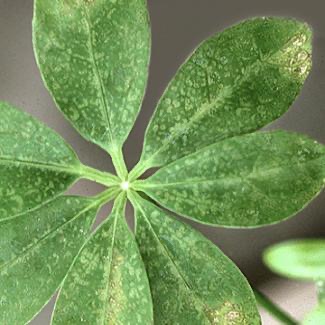Schefflera variegated Plant
Schefflera Variegated, also known as Umbrella Plant, is an indoor tree with compound leaves. Plant in well-draining soil and provide bright, indirect light. Allow the soil to partially dry between waterings. Pruning helps control its size and shape.
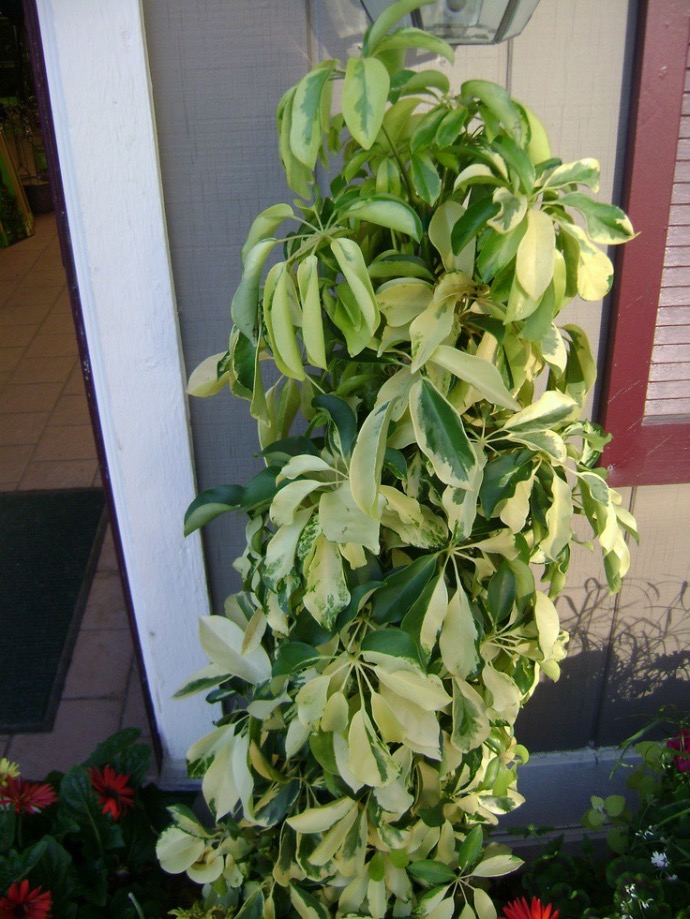
Habit
Shrub
Height
1-3 m
Growth
Moderate
Soil
Well-drained loamy
Shade
Partial shade to Full Sun
Moisture
Moist
Edible
No
Medicinal
No
Origin
Taiwan
Climatic Condition
Tropical, Subtropical
Temperature (°)
20-35°C
Humidity (%)
50-80%
Potting media
Partial shade
Fertilizers
Balanced fertilizers
Watering
Regular
Plant Weight
1-5 kg
Flowering Time
Rarely flowers
Soil Ph level
5.5 - 7.5
Water Ph level
5.5 - 7.5
Soil EC
1-2 dS/m
Yield Per Plant
Ornamental
NPK ratio
10:10:10
life Span
Perennial
Health Benefits
Ornamental, air-purifying
Suggested Grow Media or Potting Mix ?
50% peat, 25% perlite, 25% compost
Suggested Fertigation/Fertilizers
Fertilize every 2-3 weeks with a balanced fertilizer.
Common Diseases and Remedies
alternaria leaf spot , Bacterial leaf spot.
Large dark brown spots form on leaves and may have a yellow halo. Small, tan to yellow, corky, irregularly shaped spots form on the lower surface of the leaf. Spots up to 1/4 inch in diameter turn dark brown.
cut away as much diseased material as possible and dispose of it away from the plant.
HEALTH BENEFITS
Ornamental benefits: Adds greenery, which boosts mental health. (Toxic to pets if ingested.)
Air-purifying: Absorbs airborne toxins like formaldehyde.
What Is An schefflera veriegated plant?
It is an evergreen shrub growing to 8–9 m tall, free-standing, or clinging to the trunks of other trees as an epiphyte. The leaves are palmately compound, with 7–9 leaflets, the leaflets 9–20 cm long and 4–10 cm broad (though often smaller in cultivation) with a wedge-shaped base, entire margin, and an obtuse or acute apex, sometimes emarginate.
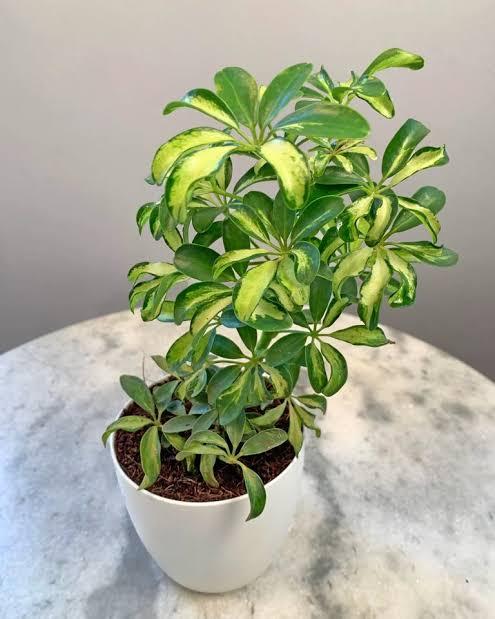
What Are The Different Types Of schefflera variegated Plants?
Schefflera arboricola 'Variegata' (Variegated Dwarf Umbrella Tree): This variety has glossy, variegated leaves with splashes of creamy white or yellow. It is a popular houseplant known for its ornamental foliage.
Schefflera actinophylla 'Variegata' (Variegated Queensland Umbrella Tree): This variety has large, glossy, variegated leaves with creamy white or yellow markings. It is less common than the dwarf umbrella tree but prized for its striking foliage.
Schefflera elegantissima (False Aralia): This species has finely divided, variegated leaves that give it a delicate appearance. It is often grown as a houseplant for its attractive foliage.
Schefflera arboricola 'Gold Capella': This variety has green leaves with bright yellow variegation along the edges. It is a striking plant that adds a pop of color to indoor spaces.
Schefflera arboricola 'Trinette': This variety has green leaves with creamy white variegation in the center. It is a popular houseplant known for its attractive foliage.
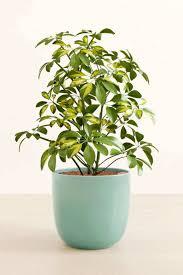
Location
Scheffleras are very popular houseplants that produce big dark or variegated palmate leaves. The leaves are made up of several smaller leaflets growing out of a single point. Place the plant in a bright, indirect light position. In the summer, it can be moved outside in a shady position.
Sunshine
Keep them in medium indirect sunlight for best growth as they can get leggy and floppy by being in low-light conditions. Water the Schefflera variegated plants only when the soil dries out entirely, then soak them in water properly.
Soil
Thrives in a rich, well-draining, acidic potting soil. Feed twice weekly during the growing season. Give water only when the soil dries out to prevent overwatering. Tolerates average indoor humidity at 30% but prefers higher humidity, preferably 40%
Hydration
Water: Schefflera appreciate a lot of humidity and moist compost. Water weekly during the growing season and spray frequently. Cut back water during winter.
Nourishment
Schefflera houseplants perform best when a balanced (20-20-20) liquid fertilizer is applied monthly during growth. Another option is to adjust to half-strength fertilizer and apply when watering every 2-3 weeks. Schefflera (Schefflera arboricola) plants are susceptible to pest and pathogen problems.
Issues
Other than dropping its leaves, Schefflera plants may face other problems. Over-watering may lead to root rot, indicated by yellow leaves, a rotten smell, or black roots. If your plant does contract root rot, remove the rotting roots and repot the plant in fresh soil..
Benifits
Oval, waxy, and robust leaves on Schefflera are shiny and almost surreal in appearance. The ability of these leaves to purify the air and freshen it naturally is arguably one of the most remarkable benefits of umbrella plants. Although these leaves naturally emit oxygen, they can also take in airborne pollutants.
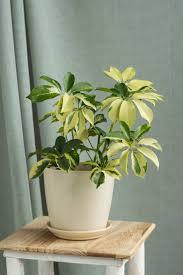
FAQs About Growing schefflera veriegate
Is Schefflera a good indoor plant?
Hardy in USDA Zones 10 to 12, schefflera plants are usually grown indoors as houseplants. They can go outdoors in the spring and summer but need to be brought indoors for the winter. Schefflera arboricola grows very fast outside, getting 10 to 25 feet tall at maturity.
Does Schefflera need a lot of water?
Schefflera Amates like to dry out significantly between waterings. The most common mistake made with these plants is overwatering. Let the soil almost completely dry out between waterings. Typically, you don't want to water your Schefflera more than once every 10 days.
Is Schefflera an air purifier?
AIR-PURIFYING AND LOVES HUMIDITY – Schefflera Nora is a big lover of humidity. It also offers itself as an air-purifying plant, making it very good for the environment.
Why do Schefflera leaves fall off?
Over/underwatering and light issues cause leaf dropping; adjust care routines. Pests and diseases lead to droopy leaves; use neem oil or insecticidal soap.
Is Schefflera poisonous to humans?
Schefflera houseplants are toxic to both humans and animals due to high levels of calcium oxalate crystals. The sap can cause mild skin irritation, and ingesting the leaves, bark, or roots can cause nausea.

